
Nettle manure: how to make it?
recipe and uses
Contents
Nettle manure is part of fermented extracts biostimulants that help stimulate the immune defenses and growth of plants, such as tomatoes, while also repelling aphids and preventing diseases. They are excellent alternatives to chemical fertilizers and plant protection products, which are harmful to the environment.
How to make nettle manure? It is very simple, effective, and free; it just requires a bit of attention during fermentation.
The necessary equipment
To make 10 litres of nettle manure, you will need:
-
- a bucket or any other non-metallic container to make the manure
- another container for filtration
- a cloth
- a string
- fresh nettles
- non-limestone and non-chlorinated water (ideally, rainwater)
- a stick
- two 5-litre containers
- a pair of gloves
- a pruning shear or a shear
- a funnel
- a kitchen scale
- a tablespoon
Read also
Nettle: a plant with many benefitsMaking manure, step by step
1) The Recipe
Always respect the following proportion:
- 1 kg of fresh nettles
- 10 litres of water
Of course, you can multiply or divide these quantities according to your needs while maintaining the same proportions.
Ideally, use rainwater at a mild temperature, between 12 and 25°C. If not, use tap water, but it should be neither hard nor chlorinated:
- hardness can clog the stomata of the leaves, thus limiting the absorption of the fermented extract by the plants. Therefore, if your water is really very hard, add vinegar at a rate of 25 cL of vinegar for 30 litres of water to rebalance the pH.
- to eliminate chlorine, you will need to let the water sit for 2 to 4 days, stirring it occasionally so that the volatile chlorine evaporates completely.
Choose a container that is slightly oversized (15 litres to prepare 10 litres of manure, for example). This makes stirring easier and prevents the nettles from being compacted.
2) The Harvest
Nettles can be easily found in the countryside, in most gardens, and along somewhat wild paths. That said, it can be laborious to find nettles in the city, and some particularly well-kept gardens may be devoid of them. Look instead towards fallow land or sow your own patch of nettles… even if this approach may seem rather original!
The harvest is preferably done in early spring, in April or even May, when the nettles are still young and of better quality. They must not be seeding lest they sprout everywhere you pour the manure.
Put on gloves to avoid stinging your hands on the urticating prickles. Using a pruning shear or shear, cut good bunches of leaves.
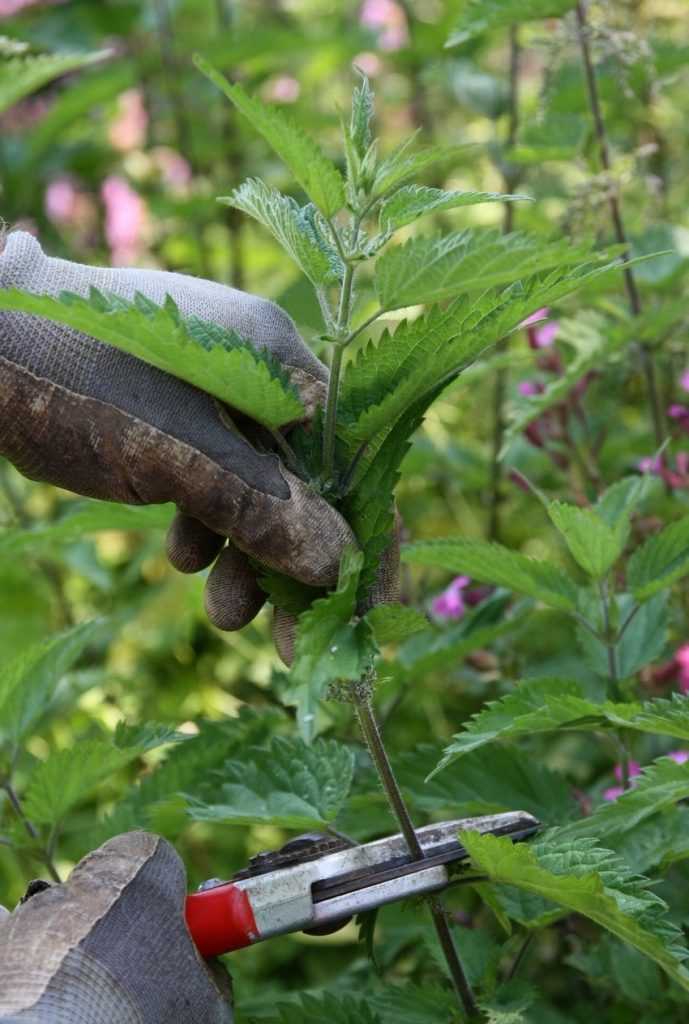 Picking nettles: don’t forget your gloves!
Picking nettles: don’t forget your gloves!
3) Preparing the Manure
It is important to choose a non-metallic container as fermentation causes oxidation of ferrous metal, which would be detrimental to the quality of the fermented extract.
- On a table, place the kitchen scale and tare it with an empty container. Add your nettles until you reach the desired weight. Once you have enough nettles, put them in your bucket. Some chop the nettles to better release their active principles, but you can perfectly place them whole in the container. You can also use a large potato sack and insert your whole nettles inside, close the bag, and place it in your container. It will help retain as many leaves as possible during filtration.
- Pour 10 litres of water over the nettles and then place a cloth over the bucket. The cloth allows air and fermentation gases to pass through.
- Place your container in a shady spot. This is to prevent it from overheating and to avoid putrefaction.
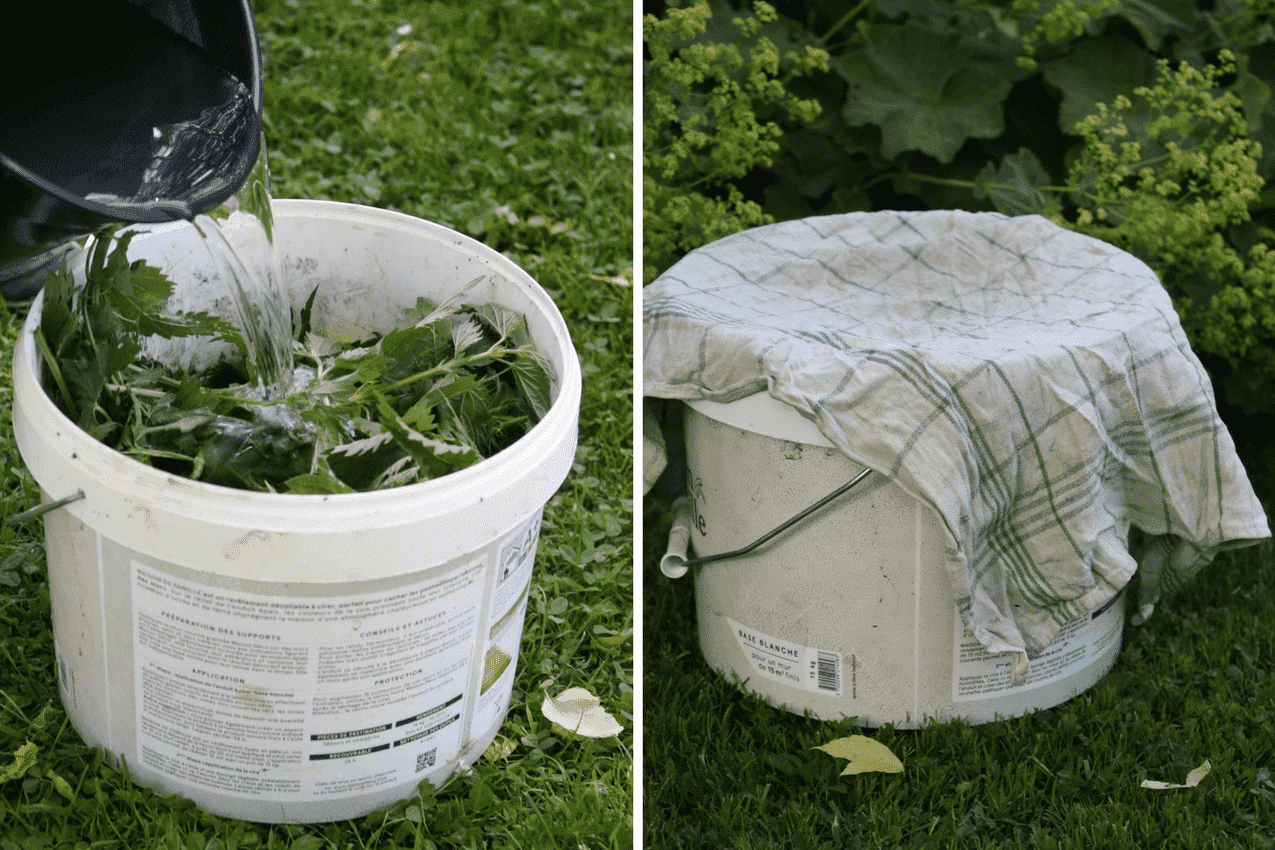 Left: pouring water over the nettles – Right: placing the bucket in the shade
Left: pouring water over the nettles – Right: placing the bucket in the shade
4) Stirring the Manure
Stir the manure at least once a day with a stick for 10 minutes. A white foam forms on the surface indicating fermentation. It should not be covered tightly as fermentation gases need to escape.
It should be noted that some gardeners make their manure in a closed container (anaerobic fermentation) while others do so without a lid (aerobic fermentation). It is the latter that is used here, and when the manure is made correctly, it should hardly smell at all.
The fermentation duration varies depending on the temperature. The onset of fermentation can take between four to ten days to appear. It continues until there is no more foam on the surface. This takes a few more days. Also, be aware that above 25°C, the risk of putrefaction is significant, hence the importance of making your manure early in the season.
It is essential to monitor closely to not miss the end of fermentation. As soon as the foam is no longer present after stirring, you must quickly filter to prevent the extract from entering putrefaction.
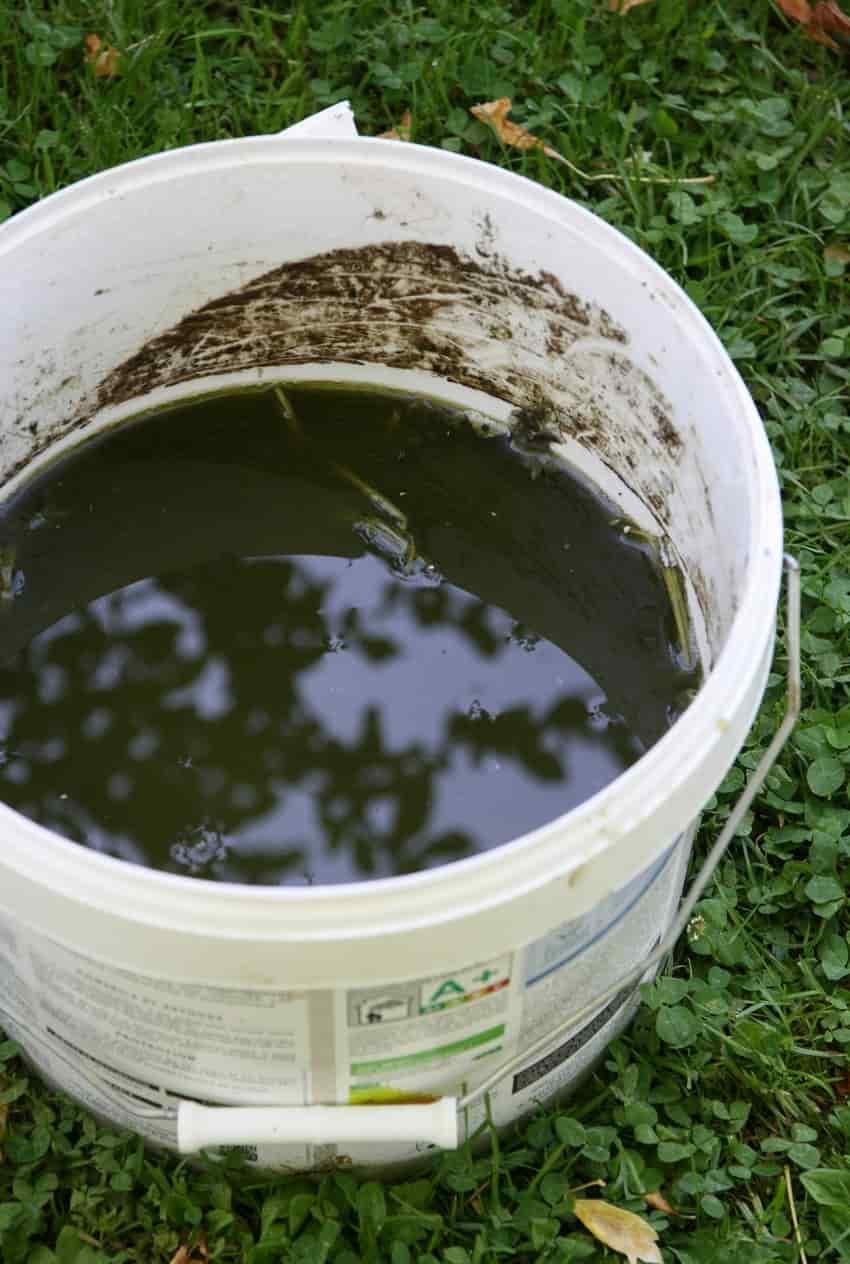 Bucket of manure waiting for filtration
Bucket of manure waiting for filtration
If the smell is really foul, it means you have failed your manure: you will need to start over.
5) Filtration
This step is important for the proper preservation of your manure. If the filtration is poorly done and there are still nettle residues, the manure will enter putrefaction. The best method is to filter finely with a cloth or sheet depending on the size of your container (make peace with the fact that it will only be used for this!).
- Place a cloth over another container and secure the string around it (just below the rim of the bucket) so that the cloth does not move.
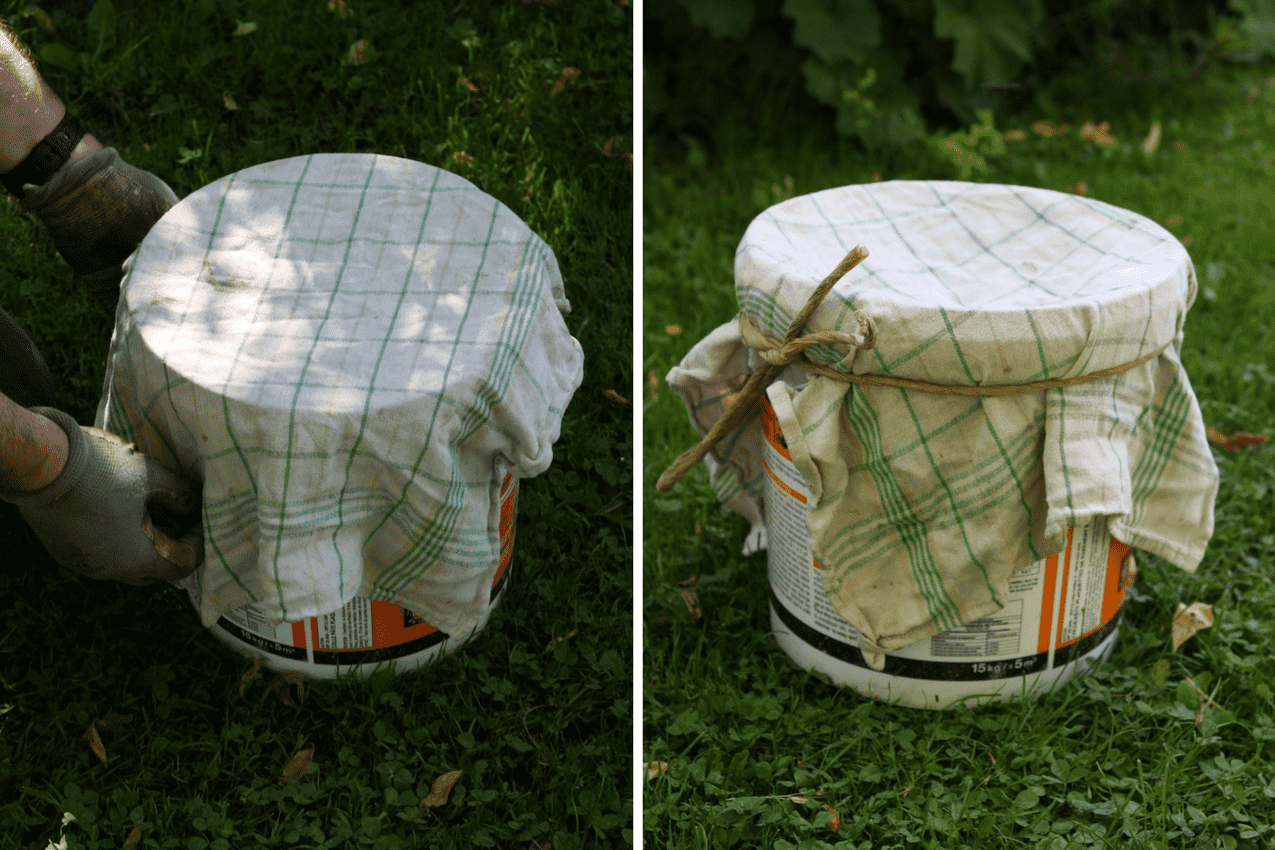 Setting up the cloth before filtering the manure
Setting up the cloth before filtering the manure
- Remove the largest pieces of nettles (this is where the potato sack, with the nettles enclosed inside, proves useful). Recycle the nettle remains on the compost heap.
- Pour the manure through the cloth. Don’t hesitate to scrape the cloth with a tablespoon to speed things up.
 Left: pour your manure through the cloth – Right: gently scrape to speed up the passage of the manure
Left: pour your manure through the cloth – Right: gently scrape to speed up the passage of the manure
If you have a sieve, you can place it over the container and simply add the cloth on top.
Finally, if you wish to use your fermented extract for spraying, ensure that your “juice” is free of impurities that could clog the sprayer nozzle.
6) Transfer the Manure into Containers
Using a funnel, pour the filtered manure into opaque (if possible) and airtight containers, and screw the lids on tightly.
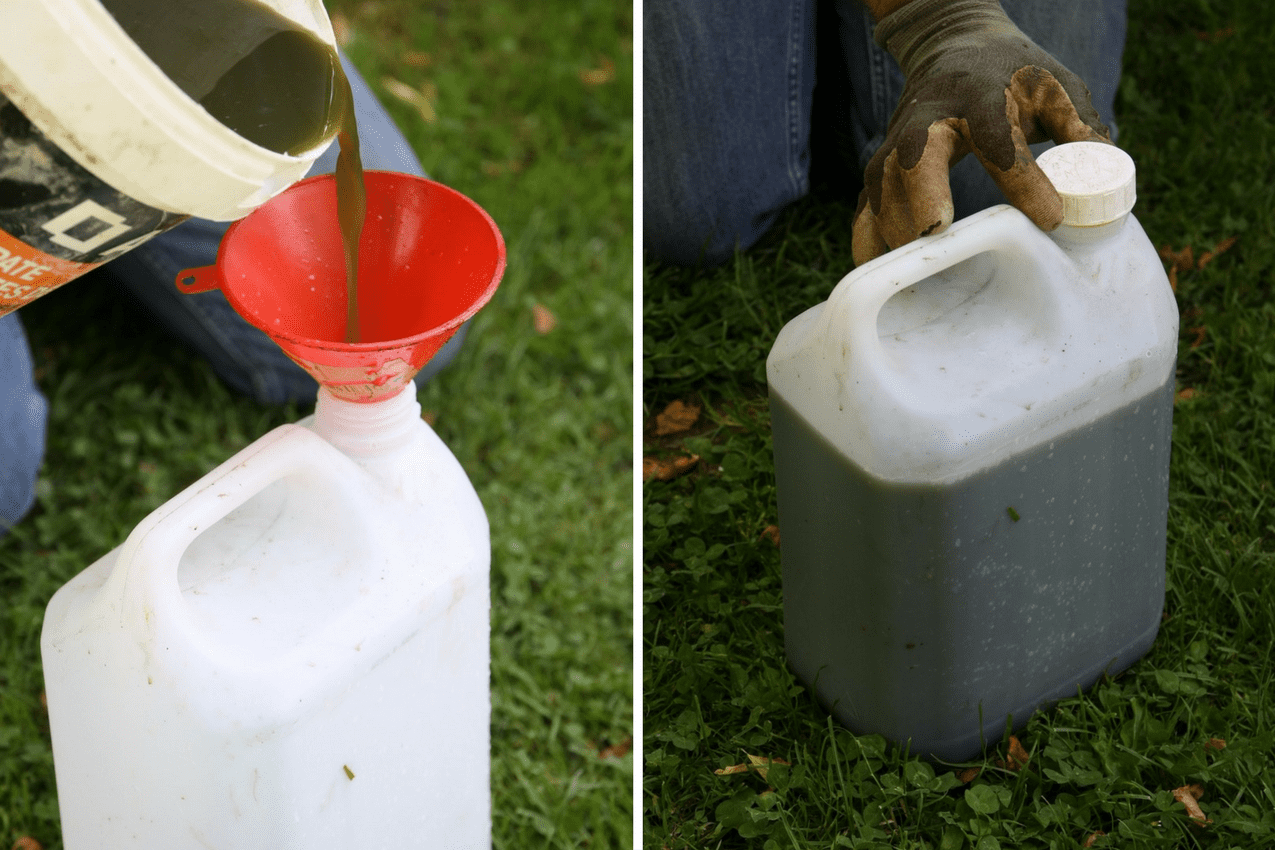 Transferring the fermented extract for preservation
Transferring the fermented extract for preservation
Don’t forget to label the container with the name of the fermented extract, especially if you are making several different manures!
The preservation of nettle manure
Manure can be stored for a year, ideally in a cellar or in a cool place (approximately 12°C) and protected from light. Beyond that, it may still be good but gradually loses its properties over time.
Be aware that a well-filled container, with as little air as possible, stores better.
It can happen that a manure, even well-filtered, continues to ferment and you will see the container swell. In this case, simply open the container, let the gases escape, and close it again.
Read also
Nourrir le sol naturellementHow to use nettle manure in the vegetable garden?
Caution: manure should never be used undiluted as it can burn your plants. It must be diluted according to its use:
- for foliar spraying to stimulate the plants’ immune defences: dilute to 5% using 250 ml (or 25 cl) of pure manure, which you complete with water in a 5-litre sprayer.
- for watering to promote growth: dilute to 10 to 20% using 1 litre of pure manure and 9 litres of water for a 10% dilution.
- for soaking to stimulate root development: dilute to 20% using 500 ml (or 50 cl) of manure and 2 litres of water.
How to proceed?
- For foliar spraying: spray the foliage, remembering to cover the undersides of the leaves and the heart of the plants.
- For watering: use a 10-litre watering can and pour the contents at the base of the plants.
- For soaking: soak the roots of your leafy vegetables or the clumps of your ornamental plants for 30 minutes in diluted manure at 20%. Nettle manure can also be added during the pralinage. Soaking seeds in pure extract for 30 minutes can prevent damping off and improve germination.
When to intervene?
Intervene when the plant needs it: after prolonged drought, a hailstorm that may have damaged the foliage and caused injuries, etc.
Spray your extract only the day after a thorough watering (never on dry soil) and never in full sun. Intervene either very early in the morning or late in the evening.
Do not spray when temperatures are below 12°C as the assimilation capacity of the leaves and roots is then slowed down. It is also unnecessary to spray when rain is imminent, as the water would leach your treatment.
Nettle manure should be used sparingly: one watering every 15 days (only at the start for growing tomatoes and other fruiting vegetables) and one foliar spray every 2 to 3 weeks is sufficient.
Which vegetables benefit from nettle manure?
- Leafy vegetables: these are the most fond of fermented nettle extract. This includes spinach, salads, cabbages, leeks, etc.
- Fruiting vegetables: use fermented extracts sparingly as their high nitrogen concentration promotes foliage at the expense of flowers and fruits. It is therefore preferable to use it at the start and then, if necessary, switch to another fermented extract like comfrey as soon as the first flowers appear. Do not use nettle manure on vegetables intended for storage, such as squashes: pumpkins, potimarrons, etc. Their storage duration would be significantly reduced.
- Root vegetables: do not use it, as they may rot.
Note that you can make mixtures of manures but separately, as the fermentation times differ depending on the plants used.
To go further
- Find our tutorial: Making your own nettle powder
- Discover our advice sheet: “Nettle: a plant with numerous benefits, in the vegetable garden and the garden”.
- Subscribe!
- Contents































Comments